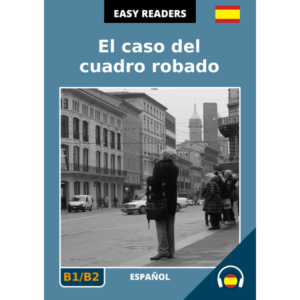Learning Spanish?
Careful not to get too obsessed with grammar books and apps…
If you’ve never tried an ‘easy reader’, that is to say a simplified Spanish story with accompanying audio, it’s definitely something you should check out.
Over at our online shop EasyReaders.org, the Spanish section has a selection of easy readers and Spanish/English parallel texts from A1 to B1 levels.
And this week, there’s a new one available!
It’s called ‘El caso del cuadro robado‘ and the level is B1/B2.
So I thought I’d check it out.
Click here (.pdf) for a FREE sample chapter so you can follow along with me.
Once you have the text you can read AND listen to it, as the audio is available free at Soundcloud.com:
https://soundcloud.com/onlineitalianclub/sets/el-caso-del-cuadro-robado
Now I’m a beginner in Spanish (I just started learning yesterday…) but I studied French at school thirty-five years ago and have lived in Italy for a couple of decades.
One Latin-origin language is pretty much like another, right?
Plus, I know the story, having edited other language versions of the same text.
So I figure I should be able to get at least something from the free sample chapter (.pdf).
But WHY read/listen in the language you’re studying?
There are loads of good reasons.
Building your listening skills at the same time as studying grammar and vocabulary will give you a head start when it comes to holding your own in conversations.
Plus, if you get used to dealing with Spanish texts and all the uncertainties they hold, that opens up a world of Spanish-language websites and media!
And lastly, though just as importantly, reading/listening to Spanish texts gives you a context for the grammar and vocabulary you’re studying in other ways.
For instance, you’ll see loads of examples of articles, tenses, and so on.
And words that you see and/or hear again and again will be much easier to remember.
OK, so let’s make a start.
First I’ll listen while following the text with my finger (or the mouse pointer) as I do so.
I’m planning not to worry about the bits I don’t understand, but just to listen until the end of the chapter without pausing or stopping the audio.
Here goes! (Why don’t you read and listen too?)
OK, wow, that was fast, wasn’t it?
Especially at first!
After a paragraph or two, though, I did get used to it and managed to follow the text, if not exactly understanding it, then at least knowing at which point we’d got to.
I’m sitting in a noisy corridor (because of the WiFi…), which doesn’t help.
I’ll try and find some place quieter and try again.
Yes, the second time, still listening and reading, went rather better! This time I could more easily pick out the words and grammar that were similar in Italian or French. Though a lot is completely new.
Normally after the ‘reading/listening at the same time’ stage, I’d suggest as a next step reading again without the audio, so taking as much time as necessary to figure out the text.
When reading, it’s important to use a dictionary only if ABSOLUTELY NECESSARY. The objective with ‘easy readers’ is not to note down and learn all the unfamiliar words, but to get some Spanish going into your brain, through your eyes and ears.
It’s not a test, no one is saying you have to learn everything you read and hear. In fact the opposite – ignore as much of the ‘noise’ as you can and just try to get the gist.
Your brain will (in time) figure out which bits are important, and learn them. With enough ‘input’ and time, it’ll be automatic, perhaps even effortless!
As a final stage, what I would usually do would be to listen again, this time WITHOUT the text support, focusing on following as well as I could, so on listening skills.
But again, it’s vital not to get stressed about all the ‘known unknowns’. Focus on what you can understand, not what you can’t.
Still, as I mentioned, ‘El caso del cuadro robado‘ is an intermediate-level text and I’m just a beginner, trying to run before I can walk.
So this time I stop here, without the second and third steps.
And next time, perhaps I’ll pick out an A1 text and try with that!
